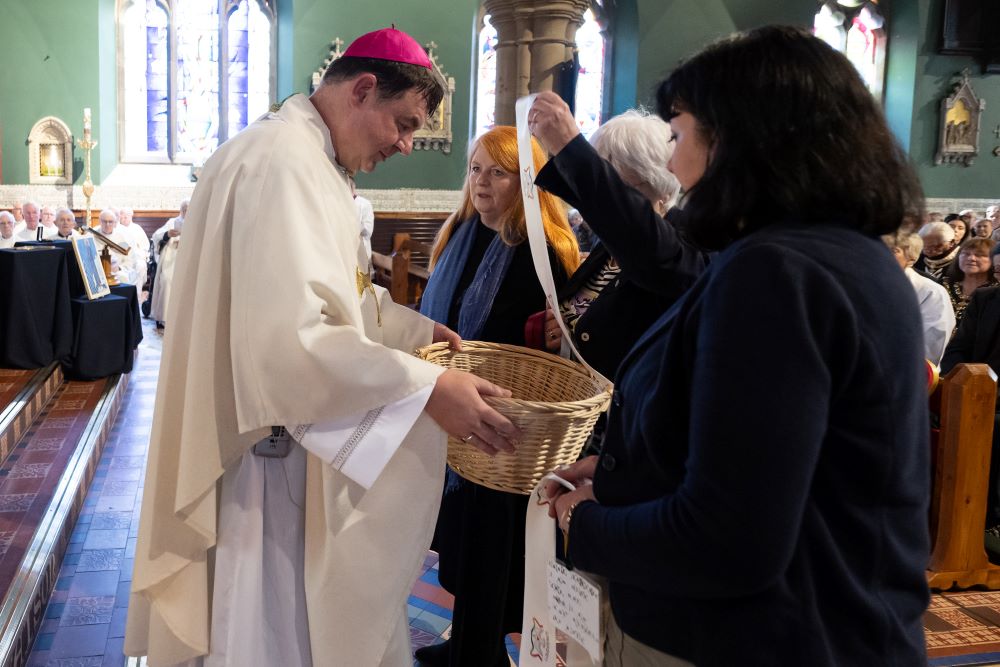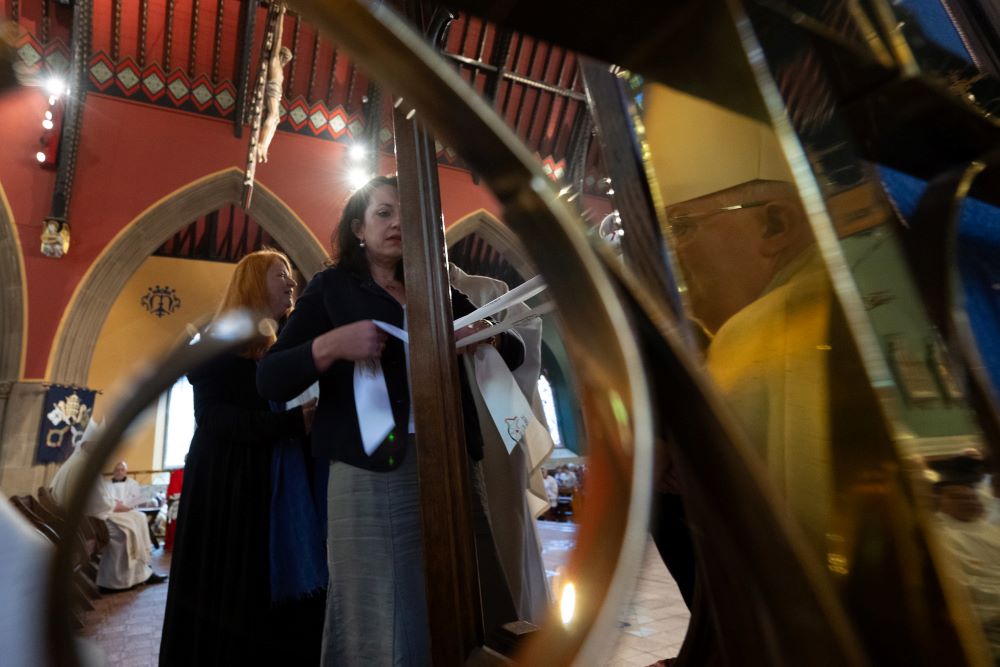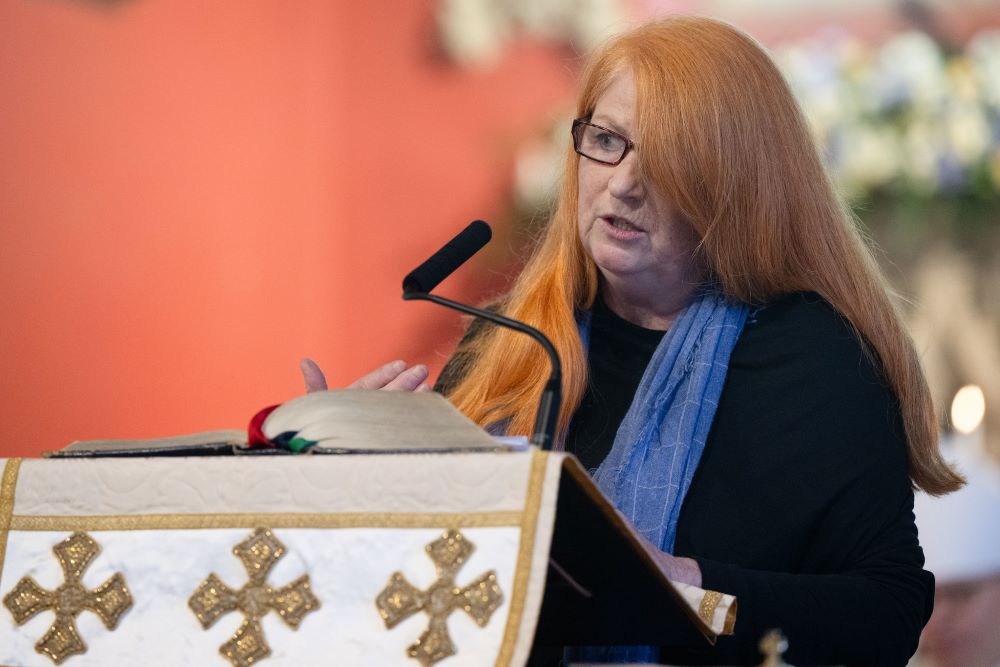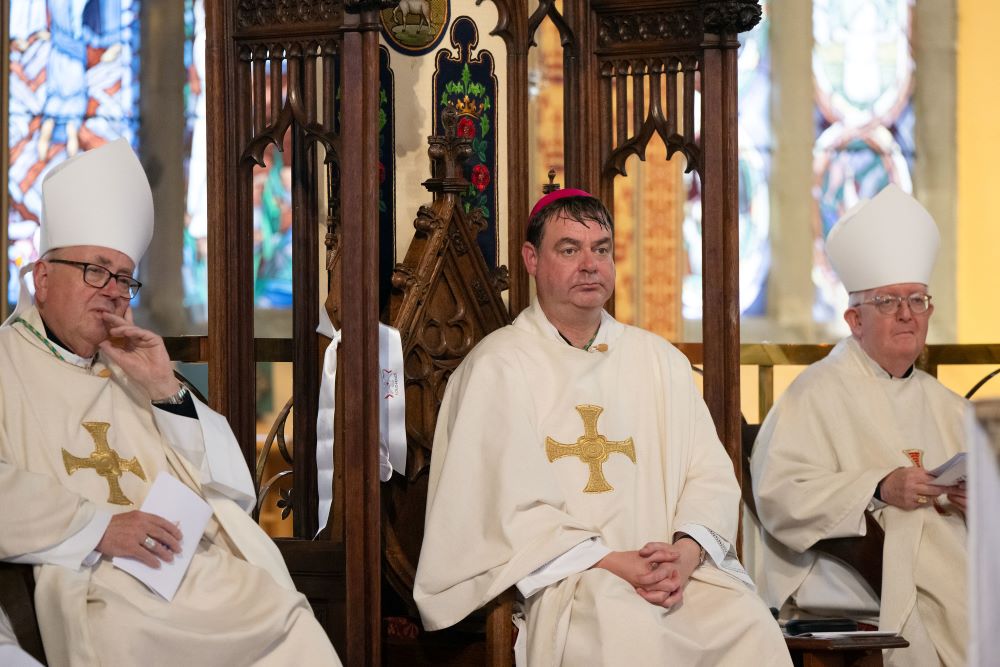
Bishop Stephen Wright, the new leader of the Hexham and Newcastle Diocese, accepts prayer ribbons representing victims of abuse during his installation service July 19. He read to the congregation the message on a ribbon, which came from 9-year-old Danny: "I may be only nine, but I am deserving of safeguarding and protection." (Catholic Church England and Wales/Marcin Mazur)
The installation of the new bishop of Hexham and Newcastle in the northeast of England was very different from the usual ceremonies to inaugurate bishops. It included a moment, without obvious precedent, that points to how a synodal, listening church can respond to the clerical sexual abuse scandal.
Thirty minutes into the liturgy, Bishop Stephen Wright, the new leader of the diocese, came down the sanctuary steps to greet three abuse survivors who presented him with prayer ribbons representing victims of abuse. These ribbons were then tied to the bishop's episcopal chair.
One of the survivors, Maggie Mathews, who had experienced abuse in the diocese as an 18-year-old, then addressed the packed cathedral in the city of Newcastle. Among those listening to her speak was the hierarchy of England and Wales, the Vatican ambassador and Cardinal Vincent Nichols, who, as the archbishop of Westminster, is the country's highest-ranking church official.
The ribbons, Mathews said during the July 19 ceremony, represent people "desperately hurt by abuse within the church, many of them abused by priests or religious," and many who are "utterly at a loss because they have clear eyes and they see the systemic nature of abuse in our church" including "the structures that lead to abuse."
Matthews said people had become "exasperated" with a church leadership that "continues to let them down so badly" and "fails to provide the mechanisms for the transparency and accountability needed to make our church a safer place." For those inside the cathedral, these were not just words but a prophetic and symbolic game changer, which put the voice of survivors at the center of the new bishop's ministry.

Members of Forcefence, which advocates for clergy abuse survivors, tie ribbons to the Bishop Stephen Wright's episcopal chair. The ribbons were tied to the chair to represent the church's role in creating the atmosphere that allowed abuse. (Catholic Church England and Wales/Marcin Mazur)
Wright's predecessor, Bishop Robert Byrne, had stepped down after being found to have ignored and undermined safeguarding in the diocese. It has been a deeply painful and troubling period for a local church with a rich history. The Hexham and Newcastle Diocese covers the northeast of England, a part of the world deeply linked to early Christianity in Britain and home to the great northern saints such as Aidan, Hild, Cuthbert and Bede.
Byrne's troubled tenure in Hexham and Newcastle has been the subject of four inquiries, including one from the Vatican's Dicastery for Bishops. The Catholic Safeguarding Standards Agency of England and Wales found "serious failures of leadership" by the former bishop, including ignoring safeguarding issues raised about a priest he promoted to a senior position in the diocese. The priest later took his own life after police announced an investigation of historical abuse allegations. The bishop was also found to have unwisely maintained a close friendship with a priest convicted of child porn offenses, even allowing him to live in the bishop's residence. One of the whistleblowers in the case, and whose advice the bishop ignored, was the diocese's former head of safeguarding, Angie Richardson.
The Hexham and Newcastle case is symptomatic of what the wider church grapples with when tackling the institutional and cultural pathologies exposed by abuse. The leadership problems Byrne's case highlight also have echoes with those identified in the Diocese of Knoxville, Tennessee, where Bishop Richard Stika resigned in June following investigations into his handling of abuse cases and alleged poor management of the diocese.
Leadership and governance will be high on the agenda at the forthcoming assembly of the Synod of Bishops in Rome in October. The synod process has repeatedly shown that abuse in the church points to an urgent need to renew church governance, including how bishops exercise their ministry. The working document for the synod says the call to "reform structures, institutions" is strong in places marked by the abuse crisis, which at its heart is a crisis about abuse of power. Establishing prevention procedures, paying compensation to survivors and making public apologies are essential first steps, but they are not enough.

Maggie Mathews, a survivor of clergy sex abuse, speaks at the installation of Bishop Stephen Wright July 19. The ribbons represent people "desperately hurt by abuse within the church, many of them abused by priests or religious," she said. (Catholic Church England and Wales/Marcin Mazur)
The archbishop of Liverpool, Malcolm McMahon, carried out the Vatican's investigation into Byrne and was the temporary leader of Hexham and Newcastle. His inquiry found the bishop made "a succession of errors of judgment" during his time in office.
I spoke to McMahon for my podcast series, "The Church's Radical Reform," which explores the ongoing synod process. He pointed to the concentration of power in the hands of the few — often identified as clericalism — as at the heart of the problem.
"I think there was a fundamental problem about governance within the diocese," he told me. "The authority within the diocese was really centered on a few priests who had several roles. There was no real distribution of authority within the church structures."
McMahon explained that he had worked to "dismantle" this arrangement and had made several changes to how the diocese is governed by including lay women in positions of authority.
He insists that the church's future must be synodal, with bishops, priests and laypeople working together. In the podcast, he talked about the effect of the synod process that has taken place in recent years in the Archdiocese of Liverpool. One change he's introduced is a bishop's advisory body of lay men and women and clergy. Local synodal councils and one for the archdiocese are also being set up.

Bishop Stephen Wright of the Hexham and Newcastle Diocese, center, sits during his installation ceremony July 19. He invited a group representing clergy sex abuse to participate in the event. The ribbons tied to his chair represent abuse survivors. (Catholic Church England and Wales/Marcin Mazur)
But the central reform, McMahon stressed, needs to be a cultural one where church structures are populated with people who act in a synodal way — those able to listen and discern. "If we can do that, then a real change will take place, and it will be like a revolution," he said.
The battle to tackle abuse in the church remains ongoing and urgent. In the Vatican, abuse survivors have cast doubt over the leadership of the pope's advisory commission, with one respected former commission member saying it's time for new leadership.
A good place to start is by giving greater space for the voice of survivors and women, as illustrated in the Hexham and Newcastle ceremony. The survivors' testimony was partly arranged by the LOUDfence movement, which was started by Antonia Sobocki, the group's project manager, from her kitchen table in Cumbria, the northwest of England, in 2020.
Sobocki says it is designed to bring "dialogue, compassion and reconciliation" between the institutional church and survivors of abuse, where ribbons are tied around a fence or similar structure. LOUDfences have been created in Anglican and Catholic cathedrals in the U.K., and the initiative has also caught on in France, with a permanent display at the bishops' conference headquarters in Paris. It is similar to the ribbon displays for survivors seen in Ballarat and Sydney cathedrals in Australia.
Wright has asked Sobocki to assist him and invited survivors to attend his installation. He didn't ask to see Mathews' words before she spoke, as she said in her testimony. The new bishop read to the congregation one of the messages on the ribbons, which came from Danny, a 9-year-old, who said: "I may be only nine, but I am deserving of safeguarding and protection."
Wright added: "May that always be the message for our diocese and the worldwide church."
[Christopher Lamb is the Vatican correspondent for The Tablet in London. "The Church's Radical Reform" podcast is sponsored by the Centre for Catholic Studies at the University of Durham in partnership with The Tablet.]








